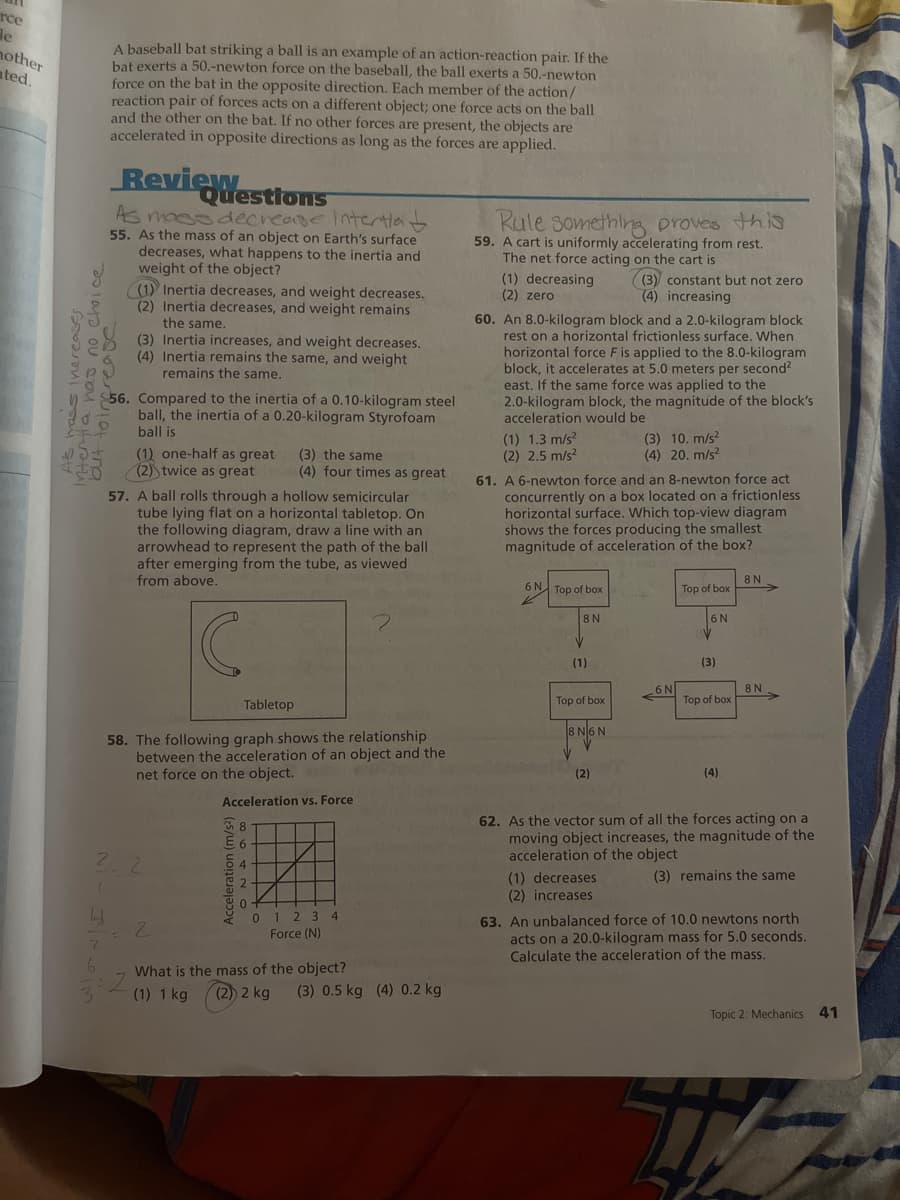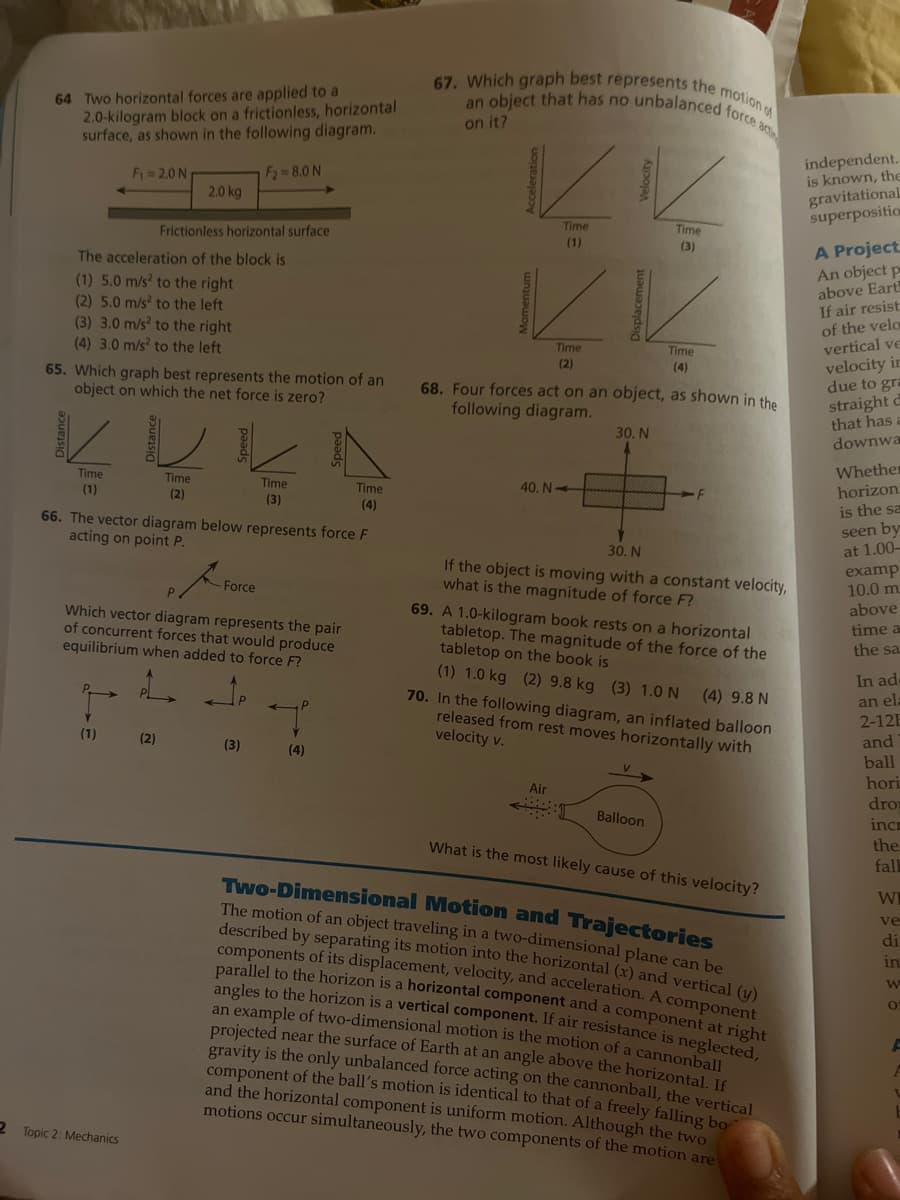55. As the mass of an object on Earth's surface decreases, what happens to the inertia and weight of the object? (1) Inertia decreases, and weight decreases. (2) Inertia decreases, and weight remains the same. (3) Inertia increases, and weight decreases. (4) Inertia remains the same, and weight remains the same. 5063
55. As the mass of an object on Earth's surface decreases, what happens to the inertia and weight of the object? (1) Inertia decreases, and weight decreases. (2) Inertia decreases, and weight remains the same. (3) Inertia increases, and weight decreases. (4) Inertia remains the same, and weight remains the same. 5063
Physics for Scientists and Engineers: Foundations and Connections
1st Edition
ISBN:9781133939146
Author:Katz, Debora M.
Publisher:Katz, Debora M.
Chapter5: Newton's Laws Of Motion
Section5.2: Newton's First Law
Problem 5.2CE: Train Collision and Newtons First Law A group of college students discusses the train collision case...
Related questions
Question

Transcribed Image Text:rce
le
nother
ated.
A baseball bat striking a ball is an example of an action-reaction pair. If the
bat exerts a 50.-newton force on the baseball, the ball exerts a 50.-newton
force on the bat in the opposite direction. Each member of the action/
reaction pair of forces acts on a different object; one force acts on the ball
and the other on the bat. If no other forces are present, the objects are
accelerated in opposite directions as long as the forces are applied.
RevieWesti
Questions
As mossdecrease intertla
55. As the mass of an object on Earth's surface
decreases, what happens to the inertia and
weight of the object?
(1) Inertia decreases, and weight decreases.
(2) Inertia decreases, and weight remains
Kule something proves this
59. A cart is uniformly accelerating from rest.
The net force acting on the cart is
(1) decreasing
(2) zero
(3) constant but not zero
(4) increasing
60. An 8.0-kilogram block and a 2.0-kilogram block
rest on a horizontal frictionless surface. When
horizontal force F is applied to the 8.0-kilogram
block, it accelerates at 5.0 meters per second?
east. If the same force was applied to the
2.0-kilogram block, the magnitude of the block's
acceleration would be
the same.
(3) Inertia increases, and weight decreases.
(4) Inertia remains the same, and weight
remains the same.
56. Compared to the inertia of a 0.10-kilogram steel
ball, the inertia of a 0.20-kilogram Styrofoam
ball is
(1) one-half as great
(2) twice as great
(3) the same
(4) four times as great
(1) 1.3 m/s?
(2) 2.5 m/s?
(3) 10. m/s?
(4) 20. m/s?
61. A 6-newton force and an 8-newton force act
57. A ball rolls through a hollow semicircular
tube lying flat on a horizontal tabletop. On
the following diagram, draw a line with an
arrowhead to represent the path of the ball
after emerging from the tube, as viewed
from above.
concurrently on a box located on a frictionless
horizontal surface. Which top-view diagram
shows the forces producing the smallest
magnitude of acceleration of the box?
8N
6N Top of box
Top of box
8 N
6 N
(1)
(3)
6N
Top of box
8N
Tabletop
Top of box
8 N6 N
58. The following graph shows the relationship
between the acceleration of an object and the
net force on the object.
(2)
(4)
Acceleration vs. Force
62. As the vector sum of all the forces acting on a
moving object increases, the magnitude of the
acceleration of the object
6.
2. 2
(1) decreases
(3) remains the same
(2) increases
1 23 4
0.
Force (N)
63. An unbalanced force of 10.0 newtons north
acts on a 20.0-kilogram mass for 5.0 seconds.
Calculate the acceleration of the mass.
What is the mass of the object?
(1) 1 kg
(2) 2 kg
(3) 0.5 kg (4) 0.2 kg
Topic 2: Mechanics 41
Acceleration (m/s?

Transcribed Image Text:an object that has no unbalanced force a
angles to the horizon is a vertical component. If air resistance is neglected,
67. Which graph best represents the motion of
64 Two horizontal forces are applied to a
2.0-kilogram block on a frictionless, horizontal
surface, as shown in the following diagram.
on it?
independent.
is known, the
gravitational
superposition
Fi=2.0 N
F2 = 8.0 N
2.0 kg
Frictionless horizontal surface
Time
Time
(1)
A Project
An object p
above Eart
If air resist
of the velo
vertical ve
velocity ir
due to gra
straight a
that has
downwa
(3)
The acceleration of the block is
(1) 5.0 m/s to the right
(2) 5.0 m/s to the left
(3) 3.0 m/s to the right
(4) 3.0 m/s to the left
Time
Time
(2)
65. Which graph best represents the motion of an
object on which the net force is zero?
(4)
68. Four forces act on an object, as shown in the
following diagram.
30. N
Whether
horizon
is the sa
Time
Time
(1)
Time
Time
40. N
(2)
(3)
(4)
66. The vector diagram below represents force F
acting on point P.
seen by
30. N
at 1.00-
If the object is moving with a constant velocity,
what is the magnitude of force F?
examp
10.0 m
above
Force
Which vector diagram represents the pair
of concurrent forces that would produce
equilibrium when added to force F?
69. A 1.0-kilogram book rests on a horizontal
tabletop. The magnitude of the force of the
tabletop on the book is
(1) 1.0 kg (2) 9.8 kg (3) 1.0 N
70. In the following diagram, an inflated balloon
released from rest moves horizontally with
velocity v.
time a
the sa
In ad
(4) 9.8 N
an el
2-12E
(1)
(2)
and
ball
hori
dro
(3)
(4)
Air
Balloon
incr
What is the most likely cause of this velocity?
the
fall
Two-Dimensional Motion and Trajectories
The motion of an object traveling in a two-dimensional plane can be
described by separating its motion into the horizontal (x) and vertical (1)
components of its displacement, velocity, and acceleration. A component
parallel to the horizon is a horizontal component and a component at right
W
ve
di
in
an example of two-dimensional motion is the motion of a cannonball
projected near the surface of Earth at an angle above the horizontal, 16
gravity is the only unbalanced force acting on the cannonball, the vertical
component of the ball's motion is identical to that of a freely falling bo
and the horizontal component is uniform motion. Although the two
motions occur simultaneously, the two components of the motion are
2 Topic 2: Mechanics
Expert Solution
This question has been solved!
Explore an expertly crafted, step-by-step solution for a thorough understanding of key concepts.
This is a popular solution!
Trending now
This is a popular solution!
Step by step
Solved in 2 steps

Knowledge Booster
Learn more about
Need a deep-dive on the concept behind this application? Look no further. Learn more about this topic, physics and related others by exploring similar questions and additional content below.Recommended textbooks for you

Physics for Scientists and Engineers: Foundations…
Physics
ISBN:
9781133939146
Author:
Katz, Debora M.
Publisher:
Cengage Learning

Glencoe Physics: Principles and Problems, Student…
Physics
ISBN:
9780078807213
Author:
Paul W. Zitzewitz
Publisher:
Glencoe/McGraw-Hill

College Physics
Physics
ISBN:
9781938168000
Author:
Paul Peter Urone, Roger Hinrichs
Publisher:
OpenStax College

Physics for Scientists and Engineers: Foundations…
Physics
ISBN:
9781133939146
Author:
Katz, Debora M.
Publisher:
Cengage Learning

Glencoe Physics: Principles and Problems, Student…
Physics
ISBN:
9780078807213
Author:
Paul W. Zitzewitz
Publisher:
Glencoe/McGraw-Hill

College Physics
Physics
ISBN:
9781938168000
Author:
Paul Peter Urone, Roger Hinrichs
Publisher:
OpenStax College

University Physics Volume 1
Physics
ISBN:
9781938168277
Author:
William Moebs, Samuel J. Ling, Jeff Sanny
Publisher:
OpenStax - Rice University

An Introduction to Physical Science
Physics
ISBN:
9781305079137
Author:
James Shipman, Jerry D. Wilson, Charles A. Higgins, Omar Torres
Publisher:
Cengage Learning

Principles of Physics: A Calculus-Based Text
Physics
ISBN:
9781133104261
Author:
Raymond A. Serway, John W. Jewett
Publisher:
Cengage Learning